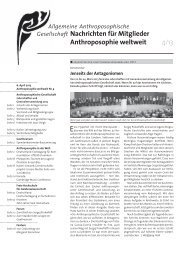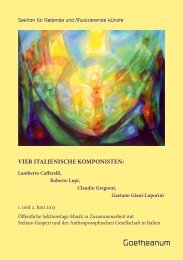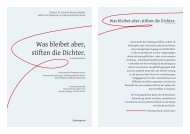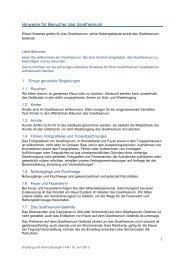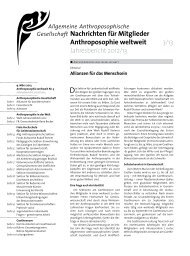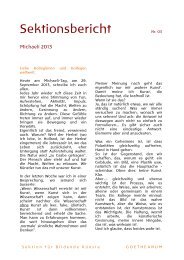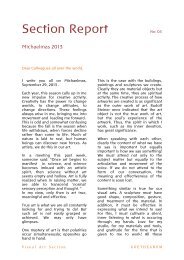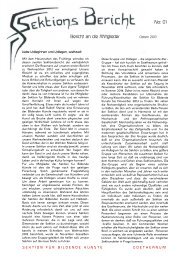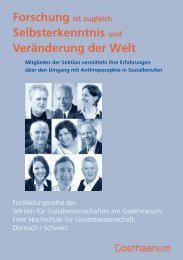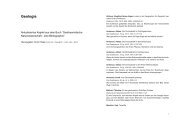Section Report - Goetheanum
Section Report - Goetheanum
Section Report - Goetheanum
You also want an ePaper? Increase the reach of your titles
YUMPU automatically turns print PDFs into web optimized ePapers that Google loves.
<strong>Section</strong> <strong>Report</strong> No: 04<br />
winter 2013/2014<br />
Dear Colleagues all over the world,<br />
In the Visual Art <strong>Section</strong> our<br />
research takes us into the realm of<br />
the will--will in man and will in the<br />
world. When doing such research<br />
we can refer to what Rudolf Steiner<br />
tells us again and again: "if you<br />
want to know yourself, look into the<br />
world; if you want to know the<br />
world, look into youself." With this<br />
in mind, we can ask: Where do I see<br />
will in the world? How can I know<br />
my own will?<br />
In principle, no one actually knows<br />
the will as it hides in the sleeping<br />
realm of the human being, in the<br />
unconscious part of our nature. The<br />
best way to know the will is in<br />
reviewing our life. When I see where<br />
my limbs have led me, then I can<br />
see what I have willed because I<br />
have done it! And after prolonged<br />
observation it can happen that<br />
something arises that I can<br />
recognize as a characteristic style,<br />
something that apparently belongs<br />
to me. Everyone has a unique<br />
character to his/her will, a<br />
'handwriting'. And only when you<br />
die can you totally know what you<br />
have willed in life, what you have<br />
done.<br />
With my head I can hardly know<br />
what I want, I have to trust that my<br />
limbs know it. But if I want to<br />
observe and know my will I must<br />
enter into the realm of the<br />
unconscious, I must wake up where<br />
I am sleeping. How am I to<br />
understand this? How am I to do<br />
this?<br />
V i s u a l A r t S e c t i o n <br />
Anthroposophy gives us many<br />
instructions and methods for<br />
meditation that help us explore the<br />
night consciousness. It is a path of<br />
'double consciousness': to be asleep<br />
while you create your work and in<br />
the same time to wake up in your<br />
consciousness. Can I see and<br />
understand what my hand is doing<br />
while it is working? Can I be aware<br />
of this without it inhibiting my<br />
activity? Can I perceive what will<br />
occur at the same time as it arises<br />
through my hands?<br />
When I try this, I discover that it is<br />
hardly possible to do. Either I 'm too<br />
awake in the doing, and then I get<br />
stuck, or I am too asleep in knowing<br />
and cannot be conscious. It is a<br />
continuous circle. But in the few<br />
moments when we are blessed to<br />
experience this a little, it is my<br />
experience that the light in my<br />
studio changes, my sense of space<br />
and time change, and I feel part of a<br />
bigger process than normally. Such<br />
experiences are among the fruits of<br />
researching the will. I hope we can<br />
continue to explore this subject for<br />
some time.<br />
The <strong>Section</strong> Council has been<br />
strengthened in its work by our new<br />
<strong>Section</strong> Leader, Marianne Schubert.<br />
Even though Marianne does not<br />
begin officially until March 2014, it<br />
is gratifying that we have begun to<br />
work together in this transitional<br />
period.<br />
We have come to a magnificent<br />
proposal for our Ascension<br />
G O E T H E A N U M
conference that will take place from<br />
May 29 to June 1, 2014. The theme<br />
will be: The Will in Connection with<br />
Life and Death. This subject has<br />
already been prepared through our<br />
November conference. In addition,<br />
we are asking, how can we reach<br />
the younger generation and include<br />
them as well? For this reason, we<br />
have already approached some<br />
younger colleagues to join us in in<br />
our preparations in hope that we<br />
can develop a program that is<br />
interesting for both younger and<br />
older colleagues.<br />
For our May 2014 conference, we<br />
propose that each older colleague<br />
bring with him/her a younger<br />
colleague under 35 - an artist, an art<br />
student, an interested person.<br />
Because we know the cost of<br />
attending a conference is<br />
challenging for many, we hope to<br />
raise funds so we can offer financial<br />
assistance to younger colleagues to<br />
help them come to Dornach.<br />
Dear colleagues, as we approach<br />
the end of 2013, we can ponder all<br />
that we have achieved this year, as<br />
well as that which we were not able<br />
to do. From this we can find joy in a<br />
sense of purpose for all there is to<br />
do in 2014.<br />
The <strong>Section</strong> Council wishes you all a<br />
good and happy New Year. May the<br />
good spirits accompany you in your<br />
art work and in your life.<br />
On behalf of the <strong>Section</strong> Council, I<br />
wish you health and joy!<br />
Rik ten Cate<br />
Interview of<br />
Marianne Schubert<br />
As part of the conference for<br />
members of the School of Spiritual<br />
Science at the <strong>Goetheanum</strong> this<br />
past November, Marianne Schubert<br />
introduced herself by sharing her<br />
life-journey as it has unfolded up to<br />
her assuming the leadership of the<br />
Art <strong>Section</strong> in March 2014.<br />
Marianne studied architecture in<br />
Darmstadt, landscape-planning in<br />
Kassel and landscape-ecology for<br />
one year in Vienna. A brief overview<br />
of her professional training makes it<br />
clear that she has a deep interest in<br />
the weaving together of people,<br />
architecture, and their place in the<br />
landscape, and that she experiences<br />
architecture as a form of social art.<br />
Marianne brings to the tasks of the<br />
Art <strong>Section</strong> both expereince and a<br />
natural disposition to build in<br />
service of others. Rather than a<br />
personal agenda to implement, she<br />
V i s u a l A r t S e c t i o n <br />
G O E T H E A N U M
aspires to build an organizational<br />
structure in which the different art<br />
impulses arising from anthroposophy<br />
can flourish. <br />
Marianne met anthroposophy when<br />
she was 28 years old, after which<br />
she attended the Waldorf teacher<br />
training in Mannheim, followed by a<br />
year of science study in Dornach, as<br />
well as courses in biography and<br />
mediation. All of this has prepared<br />
her to better understand human<br />
development and the diversity of<br />
worldviews as a basis for giving<br />
equal standing to the different<br />
anthroposophical art streams as<br />
they manifest in the life of the Art<br />
<strong>Section</strong>. Marianne would like to find<br />
a solution for how all active<br />
anthroposophical artists can work<br />
together by building a sense of<br />
community founded on shared<br />
questions rather than ready-made<br />
answers. She hopes to build liviing<br />
networks of artists from all parts of<br />
the world who would collaborate<br />
around specific areas of interest.<br />
Communication between the<br />
different art schools is important to<br />
her. She hopes to foster open<br />
dialogue between the various<br />
anthroposophiccal art trainings in<br />
order to share their views on<br />
subjects like artistic perception and<br />
finding a common language for<br />
discussing the creative process.<br />
Marianne would like to bring more<br />
life and developmental opportunities<br />
around the exhibitions at<br />
the <strong>Goetheanum</strong> by offering<br />
supporting programs like practical<br />
workshops and discussion groups.<br />
After her year of scientific studies in<br />
Dornach, Marianne remained there<br />
for 11 years with the task of<br />
landscape planning around the<br />
<strong>Goetheanum</strong>. Thus, she feels at<br />
home in Dornach, and knowing the<br />
people and their ways of working,<br />
she expects she will be able to<br />
readily integrate into the life of the<br />
<strong>Goetheanum</strong>. It is her intention to<br />
carry out her work with the greatest<br />
possible transparency. She hopes to<br />
create a place at the <strong>Goetheanum</strong><br />
where all members of the Art<br />
<strong>Section</strong> will feel welcome to<br />
exchange their views and<br />
collaborate together.<br />
Marianne sincerely invites everyone<br />
to join her in the future shaping of<br />
the Art <strong>Section</strong>.<br />
(C. Gerges)<br />
Abridged Version of two<br />
Presentations from the<br />
November Conference<br />
Fritz Wessling <br />
TRANSFORMING A PLACE<br />
What makes a place? On what levels<br />
do we work when we design and<br />
build something, p.ex. a new house?<br />
In fact, we are not only changing<br />
physical realities, or people’s<br />
sensations and feelings as they<br />
V i s u a l A r t S e c t i o n <br />
experience them: we are having an<br />
effect<br />
on all beings that belong to this<br />
place, especially the elementals that<br />
are rooted here. Some are<br />
embedded in the cosmic and local<br />
G O E T H E A N U M
context in a stable way, led by<br />
higher beings. Others are very open<br />
to influences; human acts easily<br />
imprint themselves on them and<br />
thus become a lasting presence in<br />
that place, through these beings. I<br />
suppose we all have experienced<br />
this: some places have a strong<br />
spiritual mood from the past, even if<br />
the spiritual work has ceased since.<br />
Other places have a disturbing or<br />
traumatic presence; some<br />
horrendous crime or disaster may<br />
have happened there, and it lives on<br />
in the haunting, even demonic,<br />
elementals of the place, perhaps for<br />
decades or more. Many in-between<br />
shades and qualities are possible,<br />
this is not black and white.<br />
How can you work with this more<br />
consciously? I have no theories to<br />
offer, and would rather share two<br />
concrete experiences I had.<br />
One took about an hour and a half,<br />
but made me more aware of an<br />
important aspect. In May, we went<br />
to see an exhibition in the outskirts<br />
of Lisbon. In a derelict old factory<br />
building, now in ruins, in a rather<br />
dull and uncharacteristic neighbourhood,<br />
an artistic project had<br />
been going on. A group of young<br />
artists had met and worked there<br />
every day, for many weeks, and<br />
each one ended up being in charge<br />
of one space, all of them under the<br />
open sky - the roof had collapsed<br />
long ago. There were installations,<br />
some rather delicate inserts, some<br />
ironies about the context, some<br />
research into the past, light and<br />
sound projections, et cetera – I<br />
won’t go into details. What surprised<br />
me utterly was the mood: it was<br />
light-filled, attentive, warm,<br />
creative, fun, quite different from<br />
the decrepid or run-down mood one<br />
might have expected. The change in<br />
atmosphere was almost tangible:<br />
the enthusiastic, loving, committed,<br />
unprejudiced teamwork of these<br />
V i s u a l A r t S e c t i o n <br />
young people had left a very<br />
positive trace, and the elementals<br />
were grateful - or at least that was<br />
what I experienced.<br />
The second experience has kept me<br />
busy for over three years and is still<br />
not over. Amongst other tasks, I am<br />
a part-time coworker in Casa de<br />
Santa Isabel, a therapeutic<br />
community for people with special<br />
needs, in Portugal, and thus the<br />
architect in charge of the building<br />
projects. In October 2010, one of<br />
our houses burned down, a wooden<br />
prefab built in 1983, the first home<br />
of applied anthroposophy work in<br />
our country. Destruction was<br />
complete, the cause remains<br />
unknown, and two people died.<br />
What can one do, how to decide the<br />
next steps at any moment? No one<br />
knew, no one felt prepared,<br />
everyone faced a feeling of total<br />
void, there was no plan or map. And<br />
yet, consensus was always present<br />
in the key moments of decision<br />
making: yes, this is the next step we<br />
all want to take. The place had a<br />
history of community decision<br />
making and that helped carry us.<br />
Transforming this place was clearly<br />
a community task. There was no<br />
demand for star architecture or<br />
artistic solo achievements. How the<br />
process would go, what qualities it<br />
would bring, was going to be<br />
important, not just the end result.<br />
This would, too, help shape the<br />
new, or renewed, genius of the<br />
place.<br />
One important side would obviously<br />
remain hidden, or occult: how each<br />
of us deals with the trauma<br />
personally. Everyone was having the<br />
most intense experiences but would<br />
hardly ever speak about them or<br />
expect someone else to do so.<br />
In the old Indian tradition, Brahma,<br />
Vishnu, and Shiva, are a trinity of<br />
G O E T H E A N U M
important gods: Brahma the creator,<br />
Vishnu the maintainer, and Shiva<br />
the destroyer/renewer! In the<br />
christening ritual of the Christian<br />
Community, we have the “allpermeating<br />
water, the allmaintaining<br />
salt, the all-renewing<br />
ash”. As visual artists we are of<br />
course specially attuned to the act<br />
of creation and life-giving. But life<br />
as a whole is more than that and<br />
opposite qualities are part of it, too.<br />
The disaster site needed to be<br />
cleared, the sorry sight, the<br />
blackened floor slab with remnants<br />
of the spaces had to disappear as<br />
quickly as possible; we were<br />
responsible for our student’s trauma<br />
relief, too. We also had the rubble<br />
heap removed, JCB’s and lorries did<br />
a quick job. This brought some<br />
relief to all this concentration of<br />
negative energy, and hopefully we<br />
didn’t overburden other places in<br />
the universe.<br />
Then there was a time of pralaya, a<br />
long winter with little transformation<br />
on site while the new vision was<br />
taking shape. It became clear to<br />
everyone that a garden was to be<br />
created, a welcoming, alive place<br />
with a free gesture, built in a<br />
community effort, and that the new<br />
house was to be built on a new,<br />
adjacent site. Our co-workers with<br />
help from the students built the<br />
garden, and this took nearly two<br />
years: moving retaining walls,<br />
removing old foundations and other<br />
remnants, building footpaths and a<br />
water course, planting flowers,<br />
bushes, trees. – Many colleagues<br />
were avoiding the space, especially<br />
at night, and this was difficult to<br />
overcome. All the more, something<br />
new and positive needed to be<br />
implemented there, a new chapter<br />
of the history of this place wanted<br />
to be written, a new beginning:<br />
good to see friends working there, it<br />
looks different every day, it makes<br />
V i s u a l A r t S e c t i o n <br />
you curious and you enjoy dropping<br />
by! .... Gardening has a tremendous<br />
transformative potential in this<br />
sense: people do it out of love, the<br />
plants grow and flourish by<br />
themselves, but continuous care is<br />
needed….<br />
One should not abandon such a<br />
place. It is a good thing to come<br />
back, time and again, to bring a gift,<br />
a thought, an act, a good moment<br />
shared with someone. Personally, I<br />
experienced the Foundation Stone<br />
meditation as a tremendous help.<br />
“For the Father Spirit of the heights<br />
reigns, creating being in the cosmic<br />
depths; for the will of Christ reigns<br />
in the earthly sphere, granting grace<br />
to souls in cosmic rhythms; for the<br />
cosmic thoughts of spirit, light<br />
imploring, reign in cosmic being” :<br />
this is the essence of what we are<br />
working for, and what our effort is<br />
all about. The Foundation Stone<br />
Verse also turns to the elemental<br />
world: ”The elemental spirits in East,<br />
West, North, South hear this”, and I<br />
believe in speaking this verse to<br />
these beings, repeatedly, whereever<br />
in the landscape or on a building<br />
site.<br />
An unexpected gift came right at the<br />
beginning. A building company<br />
owner had seen the news report on<br />
television, and two days later, he<br />
appeared unexpectedly in one of<br />
our emergency meetings, to let us<br />
know that he would donate a small<br />
prefab house, imitating wood in<br />
concrete. To be honest, this sort of<br />
building is of course very much<br />
against our organic and<br />
environmental convictions. But there<br />
was not a trace of doubt that we<br />
would accept, very gratefully, this<br />
gift from such a warm-hearted,<br />
empathic, generous man. A festive<br />
mood arouse when their team<br />
delivered the little house on a lorry<br />
and put it up in only two days, right<br />
next to the disaster site. As a token<br />
G O E T H E A N U M
of gratitude, our folk dance group<br />
gave a little presentation to the<br />
workmen.<br />
Designing the new main house was<br />
an obstacle race against<br />
bureaucracy and nonsense<br />
regulation. We had to make it much<br />
bigger, and waste money on a<br />
useless ventilation system, and a lift<br />
that is going to be mothballed<br />
because no people with walking<br />
disabilities currently live in the<br />
house. We went through six or eight<br />
preliminary design versions, and it<br />
bounced back twice in the approval<br />
procedures. We ended up with two<br />
units for 7 students plus co-workers<br />
each, and a main kitchen for<br />
training purposes<br />
We had no savings and immediately<br />
launched a fundraising campaign. At<br />
the same time, Portugal got drawn<br />
into a financial crisis with the threat<br />
of state bankrupcy looming. Today I<br />
would say that the gates of hell<br />
stood fairly wide open, but so did<br />
the gates of heaven! Countless<br />
people showed their best side, we<br />
could tell many stories. Abundantly,<br />
gifts were coming in, money, heart<br />
gold, it was very special….. And of<br />
course we wanted to pass this<br />
“golden” quality on to the site. We<br />
celebrated the beginning of the<br />
building works with hundreds of<br />
guests coming to share our joy.<br />
Many left their good wishes written<br />
on a flag which we then flew from<br />
the crane.<br />
good quality and fun, while sticking<br />
to budgets and schedules.<br />
The group in charge wished to have<br />
the new house painted in lasure<br />
technique. Bernth Fredriksson from<br />
Järna, Sweden, agreed to work with<br />
us, and thus the first ever<br />
professionally painted lazure project<br />
in Portugal was born! For nearly 4<br />
weeks, Bernth lead the international<br />
workshop with participants from 6<br />
different countries. We are<br />
extremely happy wih the end result,<br />
and hosting all these old and new<br />
friends as they dived for weeks into<br />
intense large scale colour<br />
experience was another stretch on<br />
our journey of genius loci<br />
transformation.<br />
The house has been in use since<br />
September, a home for 18 people.<br />
One step is still waiting for us to do,<br />
as soon as the last bureaucratic<br />
hurdles are taken: we are looking<br />
forward to celebrating inauguration!<br />
The Foundation Stone verse will<br />
then be spoken, placed into a<br />
copper dodecaedron, and built into<br />
the foundations of the new house.<br />
1) Alagoa Project, Quinta da<br />
Alagoa, Carcavelos, Portugal,<br />
16.5.-16.6.2013<br />
Also, it was important to find a good<br />
mood between people on the<br />
building site, with a fair contract and<br />
working conditions, a team spirit<br />
that unites workmen, supervisors<br />
and owner. This also contributes<br />
towards the new genius loci, and<br />
stays when the builders leave. We<br />
were lucky and found a committed<br />
and very competent contractor with<br />
a good sense of humour. So we had<br />
V i s u a l A r t S e c t i o n <br />
G O E T H E A N U M
Christine Cologna <br />
A research contribution concerning<br />
the Zodiac imaginations renewed by<br />
Rudolf Steiner in connection with<br />
the Calendar of the soul 1912/13,<br />
The contribution was influenced by<br />
the reference to the laying of the<br />
foundation stone for the first<br />
<strong>Goetheanum</strong> on 20 September 1913<br />
made by Christian Breme who held<br />
the preceeding Class Lesson :<br />
"When Mercury was in Libra ". At the<br />
beginning Christine Cologna<br />
described how and where she got<br />
the initial impulse for her work.<br />
After studying the first <strong>Goetheanum</strong><br />
for some time she visited the model<br />
building in Malsch in 1988 and<br />
through experiencing there the<br />
architecture of a Rosicrucian temple<br />
she made the decision to connect<br />
actively with this impulse. Soon<br />
afterwards she received a gift : the<br />
calendar of the soul of 1912 with the<br />
words: " ... this you need for your<br />
studies "<br />
And so it was! The instructions<br />
described there in the introduction<br />
V i s u a l A r t S e c t i o n <br />
become deeds in the cycle of the<br />
year. Described in short, they are :<br />
1.) Observation of the conditions of<br />
light before sunrise<br />
This experience is brought into a<br />
characteristic intuitive picture.<br />
Through an observation period of<br />
one year 12 different sketches based<br />
on 12 different observed light<br />
conditions emerged.<br />
2.) Spiritual background : Study of<br />
"Occult Science, an Outline" under<br />
12 specific aspects. Each of them<br />
corresponds to a state of<br />
development of the earth and<br />
humanity – an evolutionary path of<br />
the I through the zodiac. A cosmicearthly<br />
process is illuminated : the<br />
light connects with the earth in<br />
twelve different ways. The observer<br />
of the light conditions grasps, feels<br />
and forms a characteristic intuitive<br />
image corresponding to the twelve<br />
stages of the development of<br />
mankind. This should attune you<br />
cosmically to the way that sensefree<br />
thinking as inner ability owes to<br />
the Mystery of Golgotha . We retrace<br />
- following the light conditions - the<br />
development of man and the earth<br />
G O E T H E A N U M
in seven pictures from Pisces to<br />
Virgo (backwards in the Zodiac) .<br />
Pisces here is reminiscent of the<br />
beginning of the earth evolution as<br />
described in " Occult Science, an<br />
Outline" as the Saturn period,<br />
Aquarius the Sun period, Capricorn<br />
the moon period, Sagittarius the<br />
solidification of the earth. In the<br />
following three steps we are<br />
reminded in Scorpio of the Fall of<br />
Man and the associated<br />
development of independent<br />
thinking, in Libra of the individual<br />
shaping of the astral body, resulting<br />
in error, illness and death, which<br />
calls forth the deed of redemption<br />
on Golgotha .<br />
In Virgo the conditions for the<br />
human form are fulfilled. Now man<br />
can in freedom become an evolving<br />
being and start to give back to the<br />
world . This enables the<br />
development of a new organ in the<br />
heart area in Leo, the creation of a<br />
mental spine in the front in<br />
accordance to the physical spine in<br />
the back in Cancer, the<br />
development of living thoughts in<br />
Gemini, to work on the wordcreating<br />
power in Taurus and to<br />
nurture the new clairvoyance with<br />
the help of the forces of Aries. In<br />
this way there flows to earth and<br />
man out of the region of the zodiac,<br />
in twelve steps, mediated by the<br />
sunlight an always renewing power<br />
of memory. Seven Steps to build<br />
the human form and five further<br />
steps supporting the birth process<br />
of the second man. The cycle of the<br />
year as a path of initiation for the<br />
individual who wants to meet the<br />
Christ in the etheric is revealed<br />
therein. Anybody following these<br />
explanations will not be surprised<br />
that it was important for Rudolf<br />
Steiner to engrain this content in<br />
renewed signs of the zodiac .<br />
3.) Sketches by Rudolf Steiner to the<br />
zodiac imaginations were given to<br />
V i s u a l A r t S e c t i o n <br />
Imme von Eckhardstein in<br />
instruction lessons for the Calendar<br />
1912/13.<br />
4.) An artistic inner path with the<br />
background of the new art impulse<br />
inaugurated by Rudolf Steiner in<br />
shaded drawing, painting, modelling<br />
and stone sculpture – as much as<br />
possible cleansed from already<br />
accomplished talent and ideas.<br />
Exhibited were 2x12 Zodiac<br />
imaginations which were created<br />
this year during and after a trip to<br />
Norway .<br />
Then one current example of such a<br />
development was described :<br />
"When Mercury was in Libra " .<br />
Today on the 22nd november 2013,<br />
we are under the influence of the<br />
zodiac forces out of the region of<br />
Libra.<br />
1.) The spiritual background:<br />
Humanity is on the 6th of the 7<br />
steps of the development towards<br />
independence. It received its own<br />
astral body. As a result humans get<br />
to know error, sickness and death.<br />
Rudolf Steiner outlined this<br />
condition in the sign of Libra like<br />
this:<br />
the old zodiac sign,<br />
the renewed sign<br />
2.) Concerning the zodiac colors we<br />
are in violet. The painter who lets<br />
this color arise out of red and blue<br />
will be surprised : the two colors<br />
disappear into each other. An evenly<br />
foggy grey arises without<br />
boundaries, without orientation.<br />
Bold continuation leads into the<br />
realm of the night colors and to a<br />
serene and dignified space : the<br />
violet.<br />
G O E T H E A N U M
3.) For the observer of the light<br />
conditions at dawn it seems as if a<br />
light cross permeates the earth.<br />
This experience led to a further<br />
research question :<br />
Where is humanity today in relation<br />
to the development step of Libra?<br />
If we see the Mystery of Golgotha as<br />
an event that represents a new<br />
beginning for all creation, then this<br />
must subsequently also be<br />
expressed in the character of the<br />
Zodiac signs .<br />
Zodiac imagination of Libra<br />
before the Mystery of Golgotha<br />
after the Mystery of Golgotha for the<br />
human being, who starts to transform his<br />
astral body. As a result, Lucifer is overcome<br />
(flames move into the circumference)<br />
Ahriman is overcome (black cross<br />
transforms into a cross of light)<br />
from the circumference the<br />
seven planetary forces<br />
enter as rose forms.<br />
Three works of art from this path of<br />
transformation were shown<br />
(executed in gold leaf).<br />
For colleagues, who are interested in this<br />
research there exists a documentation<br />
folder to the 12 zodiac imaginations and the<br />
current anthroposophical Calendar 2013/14.<br />
Work on these issues - artistically and<br />
cognitifly - are held regularly in different<br />
locations, for example once a year at the<br />
<strong>Goetheanum</strong> in cooperation with the<br />
mathematical - astronomical section ,<br />
3 times a year in the Anthroposophical<br />
Society in Munich. . . .<br />
For more information contact<br />
Christine Cologna<br />
JOA Raphael Studienstätte<br />
Seestraße14 , 5303 Thalgau<br />
art8kunst@gmail.com<br />
2 days before the <strong>Section</strong> meeting on 20<br />
and 21.11.2013 visual artists met – like last<br />
year - to do studies on the Representative<br />
of Man and discuss issues arising from it.<br />
This annual meeting is carried by Edgar<br />
Spittler and Christine Cologna .<br />
The next meeting to which everyone is<br />
invited will take place from 19 - 20<br />
November 2014 .<br />
V i s u a l A r t S e c t i o n <br />
G O E T H E A N U M
Artist Biography <br />
of Van James<br />
I first heard the word<br />
Anthroposophy in the early 1970’s<br />
while completing my degree in<br />
drawing and painting at the San<br />
Francisco Art Institute in California.<br />
As a striving, young visual artist and<br />
musician, I was fully immersed in<br />
the dynamic counter culture<br />
movement of the time with its<br />
revolutionary ethic, free thinking<br />
attitude, and spiritual-artistic<br />
breaking down of barriers of all<br />
kinds.<br />
The goals of contemporary art<br />
appeared very exciting to me in the<br />
short term, but in the long term<br />
seemed pointed to a dead end and<br />
an abyss. Could truly new answers<br />
be found in the contemporary art<br />
scene where individual style and<br />
market value were the goals?<br />
Early on it was clear to me that art<br />
was my life's path but it was equally<br />
clear that what I could see as the<br />
avant garde movement was no real<br />
answer to life's deeper questions.<br />
With a near-death experience at the<br />
age of twenty-one a departure from<br />
my art school lifestyle for the<br />
pursuit of anthroposophy seemed in<br />
order. I left San Francisco for England<br />
and Emerson College looking<br />
for a healthier, more enlightened<br />
alternative.<br />
Through the many encounters I had<br />
at Emerson College, my painting<br />
preferences began to change from a<br />
neo-surrealistic style based on<br />
naturalistic forms juxtaposed in<br />
unnatural settings to a more translucent<br />
palette of color-oriented<br />
imagery. My teachers at that time<br />
V i s u a l A r t S e c t i o n <br />
included Frances and Elisabeth<br />
Edmunds, John Davy, William Mann,<br />
Anne Stockton, John Wilkes, Olive<br />
Whitcher, Adam Bittleston, Michael<br />
and Roswitha Spence, Julian Pook,<br />
Graham Richet, and visiting faculty,<br />
Dr. and Eva Mees, Arne Klingborg,<br />
Rex Raab, Michael Wilson, Dr.<br />
Hagen Biesantz, Rene Querido, and<br />
many others. These extraordinary<br />
G O E T H E A N U M
individuals provided a foundational<br />
picture of humanity and contemporary<br />
civilization where art could<br />
“become the lifeblood of the soul.”<br />
I had the opportunity to discuss<br />
questions of color with Liane Collot<br />
d'Herbois, Frau Dr. Margaretta<br />
Hauschka, and Michael Wilson. I<br />
painted with Arna Klingborg, Bebe<br />
Assenza, Margaret Junemann, and<br />
many others, gradually overcoming<br />
my initial distain for anthroposophical<br />
painting as something<br />
totally unprofessional and uncontemporary.<br />
I gradually found a<br />
pathway in painting that could<br />
illuminate the “truly human,” both in<br />
me and in others.<br />
But it was Gerard Wagner at an art<br />
conference, whose paintings I did<br />
not really care for at the time and<br />
who seemed to be entirely counter<br />
to my image of what a contemporary<br />
artist should be, that made<br />
the most powerful impression on<br />
me. In one moment of instruction he<br />
placed a stroke of color on my<br />
picture and I suddenly saw in a new<br />
and different way everything that<br />
was happening in my painting. I<br />
literally woke up to what was<br />
possible in the art of color. I also<br />
recognized that there was something<br />
intuitive in Wagner's gaze, that<br />
there was a zen-like experience of<br />
oneness between painter and<br />
picture. In that moment I knew that<br />
I must study with him, for here was<br />
a master - a true human being as<br />
artist.<br />
My training at the <strong>Goetheanum</strong> with<br />
Gerard Wagner over the next four<br />
years was one of the most<br />
challenging times in my life. I slowly<br />
began to shed former habits of<br />
thought and ways of doing things in<br />
response to the methodological<br />
approach to working with color that<br />
I was learning. At the end of my<br />
studies, at the age of twenty-eight<br />
and following a profound health<br />
V i s u a l A r t S e c t i o n <br />
crisis, I returned to England and<br />
taught at Emerson College, and was<br />
one of the founding teachers at<br />
Tobias School of Art (under the<br />
direction of Anne Stockton), where I<br />
worked for the next three years.<br />
By this time I was painting in a<br />
noticeably Wagnerian style. My tenyear<br />
sojourn in Europe was coming<br />
to an end and I discovered Waldorf<br />
education and its art of teaching. I<br />
moved to Honolulu, Hawai'i, and<br />
took a job as a class teacher for four<br />
years and then stayed on as the art<br />
instructor at the Honolulu Waldorf<br />
School, helping to start and build up<br />
a high school. For the next thirty<br />
years I would develop the visual arts<br />
curriculum for classes one through<br />
twelve, as well as assist in a local<br />
teacher training program and become<br />
a guest tutor in teacher<br />
training programs in several other<br />
countries. At the same time I was<br />
able to unfold my own direction of<br />
working in the visual arts, with<br />
explorations in drawing, painting,<br />
and graphic design. I also began to<br />
write about my experiences in art<br />
and art history, archaeology and<br />
education, publishing six fully<br />
illustrated books (the most recent of<br />
which is Drawing with Hand, Head<br />
and Heart, 2013, SteinerBooks).<br />
I had completed my apprenticeships<br />
and journeyman experiences and<br />
found my more mature life’s work<br />
as a teaching visual artist. The<br />
wonderful thing about teaching art<br />
G O E T H E A N U M
in a high school, preparing young<br />
people for life and helping them<br />
find their own approach to creative<br />
work, is that style becomes<br />
secondary; method, medium, and<br />
creative experimentation become<br />
primary. One learns to change style<br />
with each encounter and meet all<br />
phenomena as new, with a fresh<br />
eye.<br />
In addition to teaching and painting,<br />
I took on the chairmanship of the<br />
Anthroposophical Society in Hawai'i<br />
(a small National Society, independent<br />
of the Anthroposophical<br />
Society in America), became active<br />
in work of the School of Spiritual<br />
Science, joined the council of the<br />
North American Art <strong>Section</strong>, and<br />
founded/edited the newsletter<br />
Pacifica Journal (a bi-annual newsletter<br />
dealing with anthroposophical<br />
activities in the Asia-Pacific region).<br />
I now lecture widely throughout<br />
Oceana and Asia doing mostly<br />
teacher training work in the arts,<br />
and helping Waldorf-Steiner School<br />
teachers, artists and art therapists in<br />
the field. My own painting,<br />
illustrating, design work, and writing<br />
all weave together with the art of<br />
teaching.<br />
Art and Anthroposophy have always<br />
gone hand-in-hand in my life, giving<br />
my work purpose and direction. I<br />
am in complete agreement with<br />
Rudolf Steiner’s invocation that “Art<br />
must become the lifeblood of the<br />
soul.”<br />
V i s u a l A r t S e c t i o n <br />
G O E T H E A N U M
Obitruary for<br />
Marianne Altmaier<br />
5.1.1949 - 30.11.2013<br />
Goldblau<br />
Mitternacht<br />
- Ende und Neubeginn -<br />
in deiner Tiefe<br />
erwärmt sich die Sonne,<br />
gehüllt in den Saphirnachtmantel<br />
vom Türkismorgen umsäumt.<br />
Mitternachtsonne<br />
-Alles und Eins -<br />
in deinem Innern erglüht der Kern<br />
aus deinem Innern ertönt der Kern<br />
aussendend den Weckruf<br />
durchdringend die Sphären der<br />
Nacht,<br />
dass sie zitternd erstaunen.<br />
Mitternachtwort<br />
- Keimesfrucht -<br />
gezeugt in der Nacht<br />
geboren vor Tag<br />
hörst du die Antwort -<br />
du Königssproß!<br />
Marianne Altmaier 28.10.07<br />
(zum goldblauen Fenster)<br />
The accompanying poem by<br />
Marianne Altmaier, that she first<br />
presented in an anniversary<br />
brochure 2001-2011, is a symbol of<br />
her individuality. She put her entire<br />
creative force in the service of her<br />
chosen life’s work. She approached<br />
the world in a spirit of a spiritual<br />
search and with the open heart of<br />
her artist's soul.<br />
Whoever met her witnessed a life of<br />
Rosicrucian activity, an unflagging<br />
faith in the future despite all<br />
obstacles, and a deep heart in which<br />
there lived a helpers will. In the last<br />
year of her life, she faced a number<br />
V i s u a l A r t S e c t i o n <br />
of attacks against the good progress<br />
of her glass work that had a<br />
crushing effect on her life forces.<br />
First, she learned that the publisher<br />
of her book " Metal Color Therapy "<br />
published in Stuttgart in 2010 was<br />
going out of business, with the<br />
foreseeable loss of the remaining<br />
copies of her book. Then the<br />
application of her therapy in<br />
England was temporaily stopped<br />
due to a hospital fire. For the first<br />
time, one of her therapy glasses in<br />
the Filderklinik shattered. An then,<br />
the foundations supporting the<br />
development of her glass studio in<br />
Schwörstadt was withdrawn in the<br />
middle of a renovation and<br />
expansion process.<br />
Marianne was used to fighting but<br />
now the opposing forcces came<br />
with tremendous strength. And yet,<br />
in the week of her death so much<br />
turned again for the better: The<br />
publishing house was saved, other<br />
forces helped finance the expansion<br />
of the training center so it could<br />
continue. The first training course<br />
for metal color light therapists<br />
received their dipolmas one week<br />
after her death. A new course had<br />
been announced for next year,<br />
although now this will have to wait<br />
until the whole situation is<br />
redefined. But someone trained by<br />
Marianne wants to go to<br />
Schwörstadt to continue her work.<br />
Many artists experienced Marianne<br />
and Lucien Turcis presenting their<br />
work in the Art <strong>Section</strong> conference<br />
last May 2013 in the Rudolf Steiner<br />
Halde. Many therapists and doctors<br />
all over Europe have taken the<br />
unexpected news of Marianne<br />
Altmaier’s death with deep sorrow.<br />
They all feel a deep bond with this<br />
perfect servant of the therapeutic<br />
arts.<br />
Marianne crossed the threshold in<br />
the Filderklinik where the metal<br />
G O E T H E A N U M
color therapy was first established,<br />
and where study of her book and<br />
numerous working meetings have<br />
taken place. Friends reported: In the<br />
first days after her death, an<br />
incredible abundance of light<br />
appeared around her cast-off body.<br />
review could give the color light<br />
am 22. Januar 2014 um 19.30 Uhr.<br />
Am 22. Februar One may say that<br />
this soul in her life experience as a<br />
gift back into the etheric world.<br />
A fuller appreciation of Marianne<br />
Altmaier’s life and work must wait<br />
for another time.<br />
(Thorwald Thiersch, Dornach, 3. Advent<br />
2013)<br />
Dates<br />
Dornach, <strong>Goetheanum</strong><br />
Wie bereits im Sommer 2013<br />
angekündigt, folgen in dieser<br />
Ausgabe die Daten für<br />
die Arbeitstreffen 2014 im Rahmen<br />
der Sektion für Bildende Künste<br />
durch Sieglinde Hauer:<br />
16.1., 6.2., 27.2., 10.4., 22.5.,<br />
12.6.2014<br />
Zeit: 20.00 Uhr<br />
Ort: Stiftung Trigon, Dornachweg 14,<br />
4143 Dornach<br />
Im Herbst 2013 haben wir unsere<br />
Arbeit wieder aufgenommen, die wir<br />
vor 2 Jahren begonnen haben. Wir<br />
wollen den Kunstimpuls R. Steiners<br />
pflegen und auf dem Gebiete der<br />
Geisteswissenschaft forschen.<br />
Kontaktperson: Sieglinde Hauer,<br />
Tel. 061 701 14 37<br />
Karlsruhe, Germany<br />
Vom 19. Januar bis 2. März 2014 sind<br />
in der Christengemeinschaft<br />
Karlsruhe Bilder von Sieglinde Hauer<br />
zu sehen.<br />
Im Zusammenhang mit der Ausstellung<br />
hält Sieglinde Hauer einen<br />
Vortrag "Der Malimpuls R. Steiners"<br />
V i s u a l A r t S e c t i o n <br />
2014 um 19.30 Uhr findet ein Abend<br />
mit Musik und Rezitation statt:<br />
Rezitation: Karin Hege<br />
Musik: N.N.<br />
Adresse: Christengemeinschaft<br />
Karlsruhe, Sulzfelderstr. 2, Karlsruhe<br />
München, Germany<br />
Atelier für freies Selbst- und Sozialgestalten<br />
Rita K. Bendner und Uli Bendner, Dipl.<br />
Kunsttherapeuten (FH) Valpichlerstr. 74,<br />
80686 München, Tel. 089/ 560923<br />
Malen Herbst und Winter 2013<br />
Die zunehmende Dunkelheit führt<br />
uns nach innen. Das Naturjahr geht<br />
in den Samenzustand. Das ist für<br />
uns die Konzentration auf das<br />
Wesentliche.<br />
Aktivität neigt zur Ruhe,<br />
Vergangenes sammelt sich und<br />
kommt auf den Punkt.<br />
Im inneren Kraftraum des<br />
Vertrauens bereiten wir Zukünftiges<br />
vor.<br />
Das Malen mit dem flüssigen Licht<br />
der Aquarellfarbe fördert und<br />
begleitet diesen Wandlungsprozess.<br />
Kommen wir über die Farben zum<br />
G O E T H E A N U M
inneren Kern, wird das Zukünftige<br />
greifbar:<br />
Es hat auf uns gewartet und lädt zu<br />
seiner Gestaltung ein.<br />
Probieren Sie sich aus. Ein Einstieg<br />
in eine Malgruppe ist immer<br />
möglich, wenn ein Platz frei ist. Fünf<br />
bis maximal acht Teilnehmende<br />
ermöglichen einen individuellen<br />
Rahmen. Sie bleiben, solange sie es<br />
als sinnvoll erachten.<br />
Einzelbegleitung möglich.<br />
Zeiten: vormittags und abends (je ca<br />
2,5 Stunden) Im Atelierhaus Laim,<br />
Valpichlerstr. 74<br />
kunsttherapie-münchen.de<br />
Colofon:<br />
The section report is published by the<br />
visual art section at the <strong>Goetheanum</strong>.<br />
Editing:<br />
Christiane Gerges (Schwarzweller)<br />
Translations: Michael Howard, Frieder<br />
Löbert, Van James, Fritz Wessling.<br />
The section report is published four<br />
times per year.<br />
Please participate youself by<br />
presenting your biography , your<br />
schools, projects or dates of your<br />
events. Submissions concerning the<br />
section report to the following<br />
email address:<br />
strand@hamburg.de<br />
For more information concerning the<br />
section contact the<br />
'Sekretariat der Sektion für Bildende<br />
Künste am <strong>Goetheanum</strong>', Postfach,<br />
CH 4143 Dornach 1<br />
Tel: 0041 61 706 41 37<br />
Fax: 0041 61 706 44 01<br />
sbk@goetheanum.ch<br />
V i s u a l A r t S e c t i o n <br />
G O E T H E A N U M



